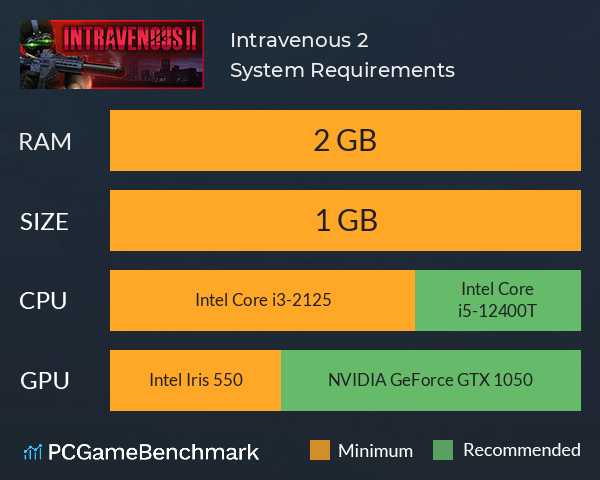Intravenous 2 System Requirements
Intravenous 2 system requirements 2025 - can your PC run Intravenous 2?
| Minimum | Recommended | |
| CPU | Intel Core i3-2125 | Intel Core i5-12400T |
| Graphics Card | Intel Iris 550 | NVIDIA GeForce GTX 1050 |
| RAM | 2 GB | 2 GB |
| File Size | 2 GB | 2 GB |
| OS | Windows 10, 64-bit | Windows 10, 64-bit |
Can you run it? Test your computer against Intravenous 2 system requirements.
Can I Run Intravenous 2?
You will need at least 2 GB of free disk space to install Intravenous 2. Intravenous 2 system requirements state that you will need at least 2 GB of RAM. An Intel Core i3-2125 CPU is required at a minimum to run Intravenous 2. However, the developers recommend a CPU greater or equal to an Intel Core i5-12400T to play the game. Provided that you have at least an Intel Iris 550 graphics card you can play the game. Furthermore, an NVIDIA GeForce GTX 1050 is recommended in order to run Intravenous 2 with the highest settings.
Intravenous 2 will run on PC system with Windows 10, 64-bit and upwards.
Looking for an upgrade? See our graphics card comparison and CPU compare for benchmarks. We'll help you find the best deal for the right gear to run the game.
Intravenous 2 FPS - what frame rate can you expect?
How many FPS will I get on Intravenous 2? We reference thousands of reports from PCGameBenchmark users running our free tool on Overwolf to tell you exactly how Intravenous 2 performs across a range of different settings and resolutions on the most popular PC gaming setups. Here’s a selection of our most recent test results.
What frame rate does Intravenous 2 run at?
Here are the typical frame rate samples
| Avg FPS | CPU | GPU | RAM |
| 136 | Intel Core i7-10700 | NVIDIA GeForce RTX 3070 | 32 GB |
| 36 | Intel Core i3-4160 | Intel HD 4400 | 8 GB |
What frame rate does Intravenous 2 run at? Check our FPS Calculator
Are you experiencing Intravenous 2 FPS drops and stutters? Want to know exactly how the game performs on your system? You can get a free easy FPS test for all your games using the PCGameBenchmark FPS monitor tool - your first step to understanding how the parts in your gaming PC are actually performing in real-world conditions.

